17 Top Link Building Statistics And Trends (2024 Guide)

What is the state of the link building industry? And do backlinks even matter any more?
In this post, we share the latest link building statistics from real link building and search engine studies published around the web.
We placed the statistics into three categories: general link building statistics, statistics on link building strategies and statistics on link building tools.
Let’s get started.
Editor’s top picks – link building statistics
Here are the top five link building statistics from this article to save you some time:
- 66.31%, or the majority, of pages don’t have a single backlink. (Ahrefs)
- On average, paid backlinks cost websites $361.44 each. (Startup Bonsai)
- Sites that have more than 30 backlinks receive at least 10,501 visits in organic search traffic on a monthly basis. (Ahrefs)
- 67.5% of SEO experts say that backlinks play a huge role in search engine rankings. (uSERP)
- 50% of SEO experts say digital press releases, content marketing and guest posting perform the strongest as link building tactics. (uSERP)
Key link building statistics
1. 66.31% of pages have zero backlinks
Ahrefs conducted a study on search traffic in 2020.
By analyzing over 1 billion pages, they were able to determine that 66.31% of pages, or 744,996,610 of the 1 billion pages analyzed, have zero external links from referring domains.

This is a pretty good indicator that ⅔ of all pages on the web have no backlinks at all.
Here are the rest of the results for full context:
- 1-3 Referring Domains: 26.29% of pages, or 295,315,940 of the 1 billion web pages analyzed.
- 4-10 Referring Domains: 5.22% of pages, or 58,628,698 of the 1 billion web pages analyzed.
- 11-100 Referring Domains: 2.1% of pages, or 23,543,028 of the 1 billion web pages analyzed.
- 101+ Referring Domains: 0.08% of pages, or 945,595 of the 1 billion web pages analyzed.
Source: Ahrefs
2. Paid backlinks cost $361.44 on average
You don’t necessarily need to pay for backlinks. However, sites with higher domain ratings do.
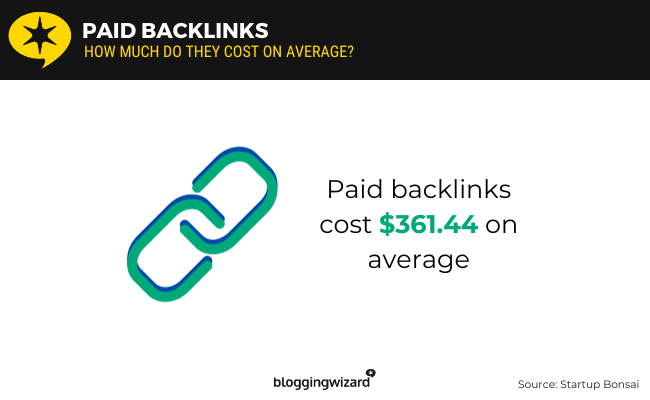
According to data published on Startup Bonsai, the average cost of a paid backlink is $361.44.
There’s also a direct correlation between domain authority and how much sites pay for backlinks.
Sites with lower domain ratings of 49 or less pay less than $400 per link while sites with domain ratings of 50 or more pay just over $600 per backlink on average.
Startup Bonsai also included data on paid guest posts, a common link building tactic.
On average, paid guest posts cost $77.44 each.
Source: Startup Bonsai
3. 46.5% of SEO professionals allocate between $5,000 and $10,000 to their link building budgets every month
When uSERP surveyed 800 SEO professionals, they discovered that 46.5%, which was the majority, spend between $5,000 and $10,000 on link building each month.
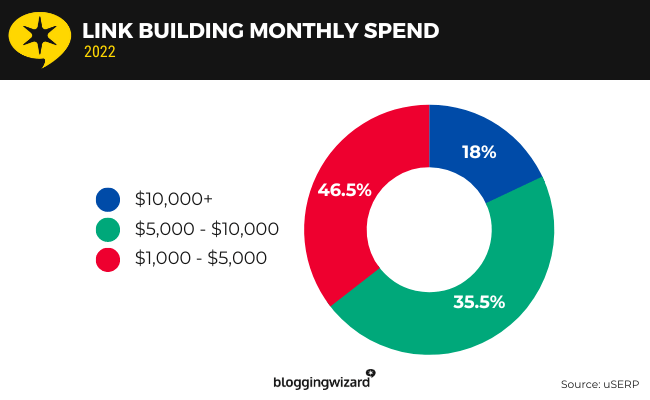
35.5% spend between $1,000 and $5,000 per month while the remaining 18% spend over $10,000.
Link building costs are hard to determine as oftentimes, it’s not as simple as paying a website “X” amount of money to insert a link on their site.
This isn’t how high-quality backlinks work, at least.
If the website you’re requesting a backlink from has a high domain authority, a lot of traffic and a huge social media following, expect to pay more.
Link building costs are also determined by the methods you use to obtain them.
While some blogs offer backlinks for free or accept them in exchange for guest articles, link building methods like digital press releases that involve high-traffic websites will often cost more.
For context, these are the types of companies these professionals do SEO work for:
- Personal Website: 25% of respondents do SEO work for their own websites.
- Freelancer/Contractor: 20% of respondents do SEO work on a freelance basis.
- Agency: 16% of respondents do SEO work as part of web design agencies who work with a variety of different clients.
- In-House SEO: 15% of respondents do SEO work as salary employees for individual companies.
- Consulting/Strategy: 12% of respondents provide SEO consultations and SEO strategy services.
- Other: 12% of respondents do other SEO work.
Source: uSERP
4. 67.5% of SEO professionals think backlinks have a big impact on search engine rankings
uSERP’s survey revealed just how important SEO professionals find linking building to be.
67.5% of SEO professionals think backlinks have a big impact on SEO while 30% think they have a moderate impact.

Only 2.5% of respondents think backlinks have a low impact on search engine rankings.
Source: uSERP
5. Sites that have between 30 and 35 backlinks receive more than 10,501 monthly visits
According to Ahrefs’ study on 1 billion web pages, there’s a direct correlation between sites that have more backlinks and sites that have a lot of organic search traffic.
Specifically, they discovered that sites with 30 to 35 backlinks receive more than 10,501 visits on a monthly basis.
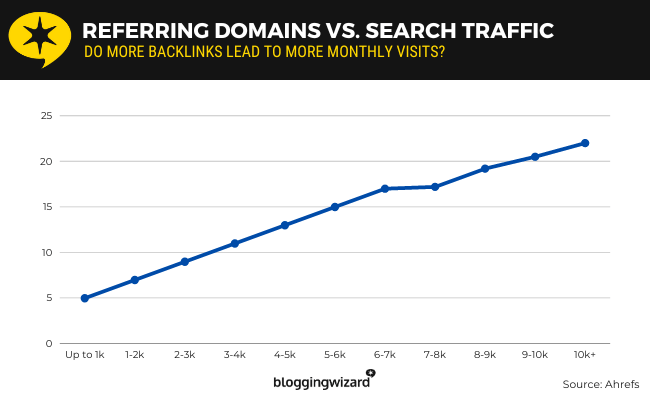
On the other side of the scale, sites with five or fewer backlinks receive 1,000 or less visits on a monthly basis.
Source: Ahrefs
6. 56.3% of SEO experts think link quality and quantity are important for link building
uSERP’s survey of 800 SEO professionals revealed a few interesting link building statistics.
It revealed that although only 7.8% of professionals think quantity is more important for link building and 35.9% think quality is important, 56.3% of respondents think both quality and quantity are important for link building.
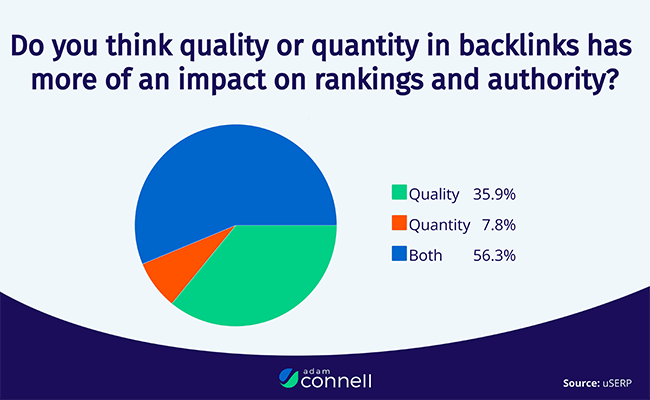
This means that while SEO professionals think quality is more than 4x as important than quantity, more than 50% think both are important.
When asked to provide more context for their response, here’s what one respondent had to say.
They explain how digital PR link building helps their company focus on earning quality backlinks rather than many backlinks:
“Building links with digital PR tactics pretty much implies that we value quality over quantity.
By creating content that’s attractive for the media (think original research, expert commentaries, visually-appealing infographics, and newsworthy stories that are timely, impactful, relevant, human-interest, or feature an influencer), sharing it with the public, and actively reaching out to relevant media contacts, we can not only build links but also strengthen the backlink profile, gain more credibility, and, ultimately, rank higher in search engines.”
– Berenika Teter, Content Manager for Ingrid, a delivery platform that connects merchants, carriers and consumers.
Source: uSERP
7. 43.9% of marketers regard keyword rankings as being the highest indicator of SEO performance
Search Engine Journal asked marketers about the performance indicators they use to measure SEO.
43.9% voted for keyword rankings.
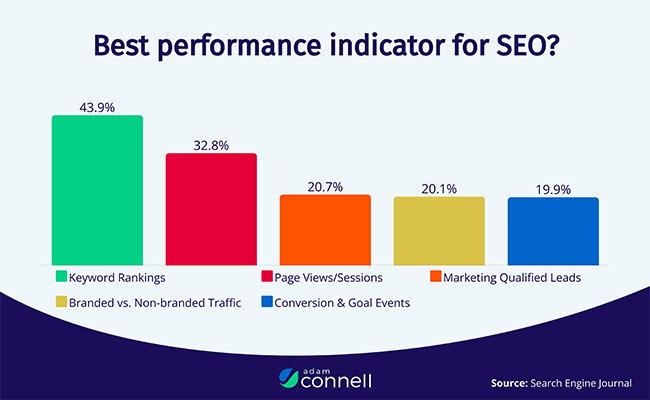
Because the majority of SEO professionals think backlinks have a big impact on search engine rankings, this means the majority of websites should work on improving or expanding their use of link building activities if they want to also improve their SEO.
These are the results for other performance indicators marketers were asked about:
- Page Views/Sessions: Voted for by 32.8% of marketers.
- Marketing Qualified Leads: 20.7%
- Branded vs Non-Branded Traffic: 20.1%
- Conversion & Goal Events: 19.9%
Source: Adam Connell
Statistics on link building strategies
8. 49% of marketers believe it typically takes one to three months to see results from implementing link building strategies
Marketers were asked about the length of time it takes to start seeing results when they implement new link building campaigns.
49% of marketers, or the majority, say it typically takes one to three months to start seeing results from a single link building campaign.
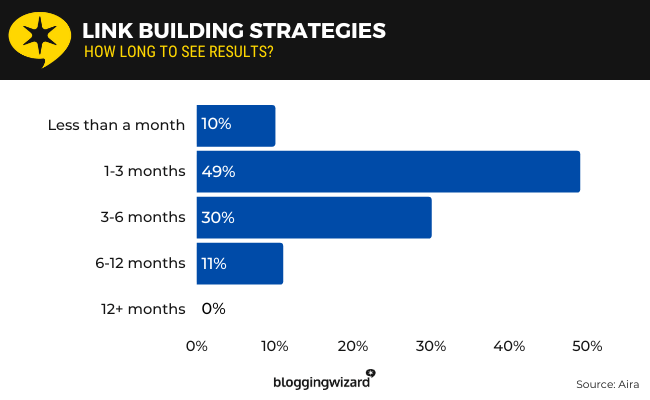
Here are metrics for other time frames Aira included in the survey question:
- Less than a month: – Voted for by 10% of respondents.
- 3-6 Months: 30%
- 6-12 Months: 11%
- 12+ Months: 0%
Source: Aira
9. 62% of SEOs think the topic where the backlink is placed is the most important factor when determining relevance
Aira asked SEOs about the methods they use to determine whether or not a link is relevant to the page they’re linking to.
62% said the link’s topic is the most important factor.
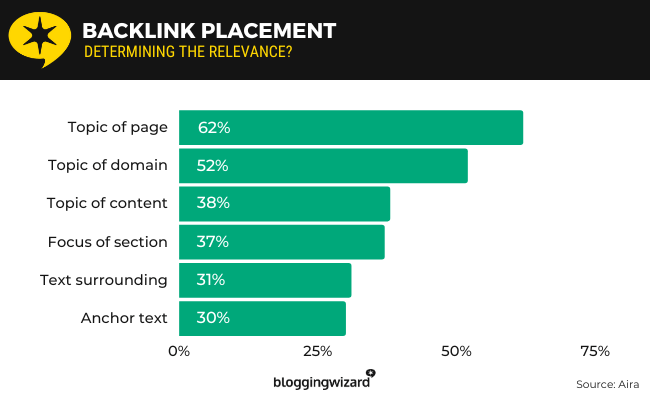
Here are the results for other factors included in the survey:
- Topic of the Domain Where the Link is Placed: 52% of respondents think this is the most important factor when determining link relevancy.
- Topic of the Content You’ve Created: 38%
- Focus of the Section Where the Link is Placed: 37%
- Text Surrounding the Link: 31%
- Anchor Text of the Link: 30%
Source: Aira
10. 41% of marketers use content marketing strategies as primary link building tactics
When uSERP surveyed 800 SEO experts about the link building tactics they use, 41% reportedly use various content marketing strategies to build links.
13% use what we typically mean when we refer to “content marketing,” such as blogs.
However, 16% also use digital press releases while 12% use guest posting.

Here are the other link building tactics that were included in the survey as well as their scores:
- Link Insertions: Used by 10% of SEO experts as a link building tactic.
- Link Exchanges: 10%
- Unclaimed Brand Mentions: 10%
- Directory Link Building: 9.5%
- Redirecting Domains: 8.5%
- Broken Link Building: 5%
- Press Releases: 4%
Source: uSERP
11. 50% of SEO experts say content marketing strategies perform the strongest when used as link building tactics
uSERP’s survey also revealed that 50% of SEO experts voted for those same content marketing strategies as being the best performers when used as link building tactics.
To be more specific, 20% say digital press releases perform the strongest among all tactics.
18% say content marketing while 12% say guest posting.
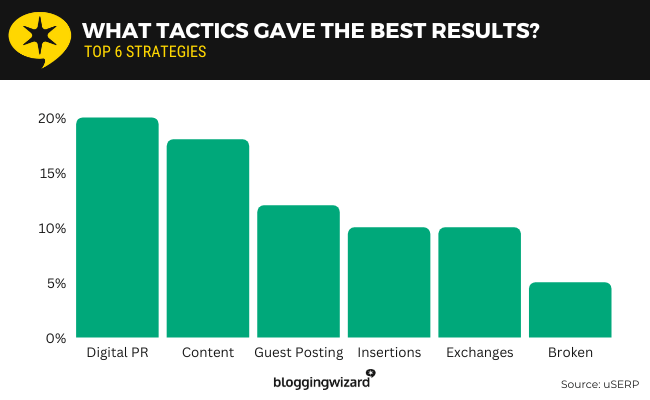
Here are the results for the other tactics:
- Unclaimed Mentions: Voted for by 12% of all SEO experts.
- Link Exchanges: 10%
- Link Insertions: 10%
- Directory Link Building: 5%
- Redirecting Domains: 5%
- Broken Link Building: 5%
- Press Release: 2%
Source: uSERP
12. 69% of SEOs think buying backlinks is an effective backlink strategy
The phrase “buying backlinks” can mean a few different things, including the act of simply having a link appear on a web page in exchange for money.
“Buying backlinks” may also refer to the practice of creating content that includes a backlink, then selling that content to outside sources.
According to Aira’s survey, 69% of SEOs think buying backlinks is an effective link building strategy that can positively influence rankings.

Source: Aira
13. 88% of SEO professionals believe nofollow links provide just as much authority as dofollow links do
Nofollow links have been the subject of many a debate over the years.
URLs have special tags that tell search engine crawlers, such as Googlebot, what they’re supposed to do with them.
Two such tags are the “dofollow” and “nofollow” tags.
When you insert an external link on a page on your site, you have the ability to make it dofollow or nofollow.
A dofollow tag tells the search engine crawler to follow the link and transfer link equity, also known as link juice, between your web page and the page you’re linking to.
A nofollow tag tells the search not to follow the link or transfer link juice between the two pages.
Nofollow links are thought of as being completely cut off from the ability to impact search rankings, which is why this statistic is so surprising.
When asked whether or not they think nofollow links improve authority and search engine rankings, 54% of SEO professionals said yes.
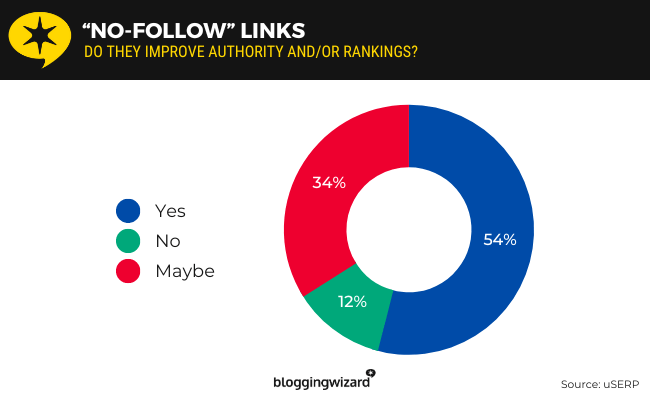
34% said maybe while the remaining 12% said no.
This means 88% believe nofollow links are still able to improve rankings despite not being able to transfer link equity.
Here’s what Dima Suponau, co-founder of Number for Live Person, has to say about nofollow links being important for authority even if they don’t transfer link equity:
“I totally agree with the point that nofollow links are valuable, bring authority and recognition. The biggest outlets out there stick with Google’s agenda on links and almost all of their links are nofollow, no matter how they got them.
But, having a backlink on their websites is still worth an effort since even though the link is nofollow, it generates traffic to your website. Personally I have backlinks on Forbes and they are nofollow, but I believe they are far more valuable than dofollow links from websites with no significant traffic and authority.”
Source: uSERP
14. 58% of SEOs think that backlinks leading to the page you’re trying to rank is most important when using link building strategies to rank a specific page
Aira’s survey revealed that 58% of SEO professionals think backlinks that lead to your target page are more important when using link building strategies to get that target page to rank.
The site also included “links to the domain as a whole” as an option.
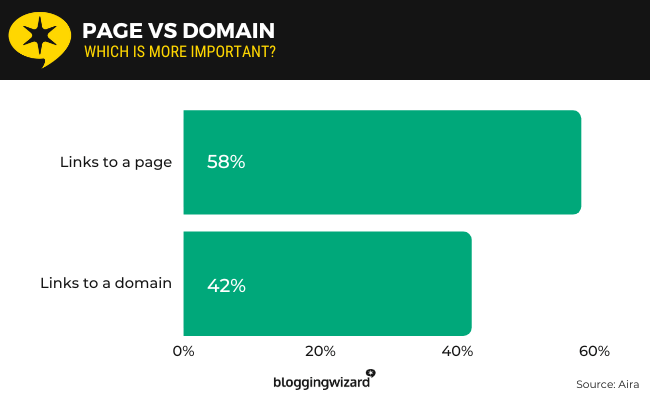
42% of SEO professionals chose that option.
While this isn’t a 50/50 split, it is a pretty good indicator of how many SEO professionals believe backlinks leading to your domain in general can have a positive effect on getting pages to rank sitewide.
Source: Aira
15. 72% of SEO professionals focus on acquiring backlinks from sites related to their niche
In Aira’s survey, the company asked SEO experts about the types of links they focus on when implementing link building strategies.
72% focus on acquiring links from sites that share the same niches as their target sites.
Other popular strategies include acquiring backlinks from sites they’ve never received backlinks from, which was voted for by 52% of respondents.
Here are other popular link types SEO professionals focus on acquiring:
- Links from Sites with High Domain Authority Scores: Voted for by 42% of respondents.
- Links from Domains Competitors Have Backlinks from: 29%
- Links from Sites Your Audience Frequently Visits: 25%
- Links That Send Traffic: 21%
- Links That Send Traffic That Goes On to Convert: 13%
- Links That Get Clicked On: 13%
- Brand Mentions: 6%
- Nofollow Links: 1%
Source: Aira
Statistics on link building tools
16. The global SEO software market will reach $1.6 billion by 2027
According to research conducted by Research and Markets, the global SEO software market will reach $1.6 billion by 2027.
The market was estimated as being worth $626.5 million in 2020.
This means the market will grow at a compound annual growth rate (CAGR) of 14.4%.
Source: Blogging Wizard
17. Google Search Console is the most widely used link building tool with 25% of SEO professionals reportedly using it
When uSERP surveyed 800 SEO experts, they asked them about the tools they use for link building.
They discovered that 25%, which was the majority, use Google Search Console.
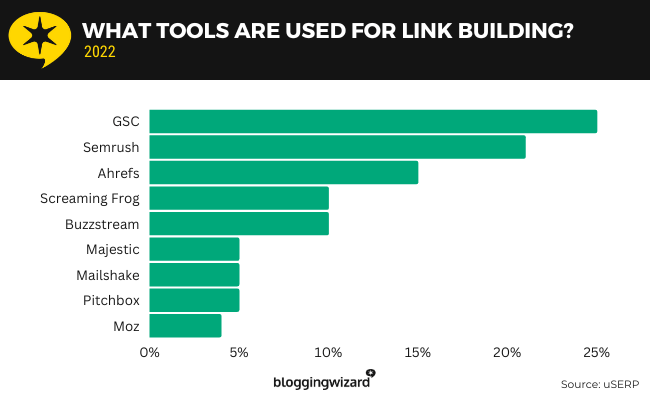
Here are usage rates for other popular link building tools:
- Semrush: Used by 21% of SEO professionals.
- Ahrefs: 15%
- Buzzstream: 10%
- Screaming Frog: 10%
- Pitchbox: 5%
- Mailshake: 5%
- Majestic: 5%
Source: uSERP
Sources
Final thoughts
That concludes our list of the latest link building statistics. We hope it inspired you in one way or another.
Link building is an important aspect of SEO, one your site won’t get far without if you don’t actively implement its strategies.
Many sites try to get by on blogs and social media posts alone, but this isn’t an effective way to earn quality backlinks, at least not in a timely manner.
We won’t mention specific statistics, but according to the data in this post, you should focus on the following aspects of link building:
- Utilizing digital press release tactics, content marketing and guest posting more than other link building strategies.
- Acquiring backlinks from sites that are related to your niche and have high domain authorities.
- Seeing nofollow links as being just as important for SEO than dofollow links.
There are many additional tips hidden behind statistics throughout this article, but these are among the biggest takeaways in terms of actually implementing link building strategies.
While you’re here, you may find these stats articles helpful:
